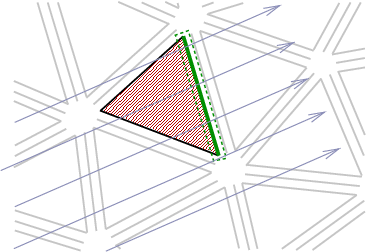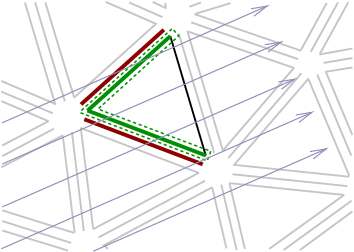This page was generated from unit-3.5-surfacehdg/surfacehdg.ipynb.
3.5 Scalar PDE on surfaces (with HDG)¶
We are solving the scalar linear transport problem
\[\partial_t u - \varepsilon \Delta_\Gamma u + \operatorname{div}_\Gamma ( \mathbf{w} u ) = 0 \quad \text{ on } \Gamma,\]
where \(\Gamma\) is a closed oriented surface in \(\mathbb{R}^3\).
[1]:
from ngsolve import *
import netgen.gui
from math import pi
Mesh of (only) the surface:¶
We consider the unit sphere (only surface mesh!)
[2]:
from netgen.csg import *
geo = CSGeometry()
geo.Add(Sphere(Pnt(0,0,0),1).bc("sphere"))
[2]:
0
[3]:
from netgen.meshing import MeshingParameters
from netgen.meshing import MeshingStep
mp = MeshingParameters(maxh=0.5, perfstepsend = MeshingStep.MESHSURFACE)
mesh = Mesh(geo.GenerateMesh(mp=mp))
Start Findpoints
main-solids: 1
Found points 0
Analyze spec points
Find edges
0 edges found
Check intersecting edges
CalcLocalH: 2 Points 0 Elements 0 Surface Elements
Start Findpoints
main-solids: 1
Found points 0
Analyze spec points
Find edges
0 edges found
Check intersecting edges
Start Findpoints
main-solids: 1
Found points 0
Analyze spec points
Find edges
0 edges found
Check intersecting edges
Surface 1 / 1
load internal triangle rules
Surface meshing done
0 illegal triangles
Optimize Surface
Edgeswapping, topological
Smoothing
Combine improve
Smoothing
Edgeswapping, metric
Smoothing
Combine improve
Smoothing
Edgeswapping, metric
Smoothing
Combine improve
Smoothing
126 elements, 65 points
SplitSeparateFaces
Update mesh topology
Update clusters
[4]:
order = 4
if order > 0:
mesh.Curve(order)
Draw(mesh)
Curve elements, order = 4
Update clusters
Curving edges
Curving faces
Tangential velocity field:¶
[5]:
t = Parameter(0.)
b = CoefficientFunction((y,-x,0))
Draw (b, mesh, "b")
eps = 5e-5
some local quantities¶
normal, tangential, co-normal and mesh size
[6]:
n = specialcf.normal(mesh.dim)
h = specialcf.mesh_size
local_tang = specialcf.tangential(mesh.dim)
con = Cross(n,local_tang) #co-normal pointing outside of a surface element
bn = InnerProduct(b,con)
Discretization¶
Surface FESpaces:¶
[7]:
fesl2 = SurfaceL2(mesh, order=order)
fesedge = FacetSurface(mesh, order=order)
fes = FESpace([fesl2,fesedge])
u,uE = fes.TrialFunction()
v,vE = fes.TestFunction()
surface gradients, co-normal derivatives and jumps:¶
[8]:
gradu = u.Trace().Deriv()
gradv = v.Trace().Deriv()
jumpu = u - uE
jumpv = v - vE
dudn = InnerProduct(gradu,con)
dvdn = InnerProduct(gradv,con)
Diffusion formulation (Hybrid Interior Penalty on Surface):¶
\[ \sum_T \int_T \nabla u \nabla v
- \sum_T \int_{\partial T} n \nabla u (v-\widehat v)
- \sum_T \int_{\partial T} n \nabla u (u-\widehat u)
+ \frac{\alpha p^2}{h} \sum_F \int_F (u-\widehat u)(v-\widehat v)\]
[9]:
a = BilinearForm(fes)
# diffusion
dr = ds(element_boundary=True)
alpha = 10*(order+1)**2
a += eps*gradu * gradv * ds
a += - eps*dudn * jumpv * dr
a += - eps*dvdn * jumpu * dr
a += eps*alpha/h * jumpu * jumpv * dr
Convection formulation (Hybrid Upwinding):¶
\[ \sum_T \int_T - u \mathbf{w} \cdot \nabla v
+ \sum_T \int_{\partial T} (\mathbf{w} \cdot \mathbf{n}) u^{hyb-upw} v
+ \sum_T \int_{\partial T_{out}} (\mathbf{w} \cdot \mathbf{n}) (\hat{u} - u) \hat{v}\]
with
\[\begin{split}u^{hyb-upw} = \left\{ \begin{array}{cll} u & \text{if } \mathbf{w} \cdot \mathbf{n} & (outflow), \\ \hat{u} & \text{else} & (inflow) . \end{array} \right.\end{split}\]
outflow |
inflow |
|---|---|
|
|
[10]:
a = BilinearForm(fes)
# convection (surface version of Egger+Schöberl formulation):
a += - u * InnerProduct(b,gradv) * ds
a += IfPos(bn, bn*u, bn*uE) * v * dr + IfPos(bn, bn, 0) * (uE - u) * vE * dr
a.Assemble()
assemble BND element 124/124
[10]:
<ngsolve.comp.BilinearForm at 0x7f4524dd9c30>
Mass matrix:¶
[11]:
m = BilinearForm(fes)
m += u*v*ds
m.Assemble()
assemble BND element 124/124
[11]:
<ngsolve.comp.BilinearForm at 0x7f4524e03230>
\(M^\ast\)-matrix for implicit Euler¶
[12]:
dt = 0.02
mstar = m.mat.CreateMatrix()
mstar.AsVector().data = m.mat.AsVector() + dt * a.mat.AsVector()
mstarinv = mstar.Inverse()
from math import pi
T = 8*pi
call pardiso ... done
Time stepping¶
Visualization of solution (Deformation in normal direction)¶
[13]:
gfu = GridFunction(fes)
gfu.components[0].Set(1.5*exp(-20*(x*x+(y-1)**2+(z)**2)),definedon=mesh.Boundaries("sphere"))
Draw (gfu.components[0], mesh, "u")
Draw (gfu.components[0]*n, mesh, "un", sd=4, autoscale=False)
res = gfu.vec.CreateVector()
SetVisualization(deformation=True)
setvalues element 124/124
The time loop¶
[14]:
t.Set(0)
for i in range(int(T/dt)):
res.data = m.mat * gfu.vec
gfu.vec.data = mstarinv * res
Redraw(blocking=True)
t.Set(t.Get()+dt)
Remark:¶
We can apply static condensation as in the volume

